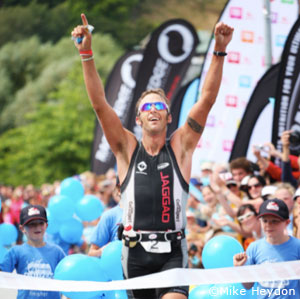Team Challenge expands
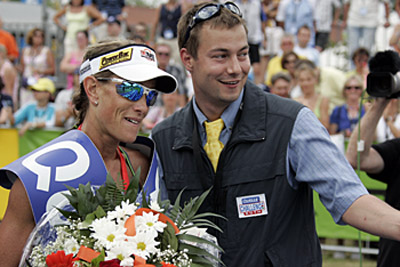
After the 2001 split with the World Triathlon Corporation, the historic Ironman Germany in Roth wasn't given much of a chance to survive on its own without the lure of Kona slots. “Ninety nine percent of the people thought we would survive for just a year and that would be it after 14 years of historic races and great success,” said current Challenge race director and CEO Felix Walchshofer. “But instead of doing the WTC a favor to just die, we came back. And in three years we came back strong and the race sold out again and we had loyal customers.”
By adhering to a strategy that invested the old WTC sanction money in star power, draft busting, drug testing and making a warm concern for their athletes and perfectionist race organization their trademark, the newly minted Quelle Challenge Roth emerged better than ever. Two years after the schism, Roth was filled to its old limit. In the next few years, they expanded to over 4,000 competitors — 2,500 individuals and 1,500 members of teams – retaining its status as a media magnet and making it the largest long course triathlon in the world.
Five years after declaring independence, Felix Walchshofer and his Roth team achieved economic security and, arguably, competitive parity with the WTC’s powerful new Ironman in Frankfurt. And so, in an era of unparalleled worldwide growth, with virtually all 23 full Ironman races and 32 Ironman 70.3 races sold out, the old concept of zero sum rivalry seems dead. WTC cannot answer all the surging worldwide demand and does not want to risk quality depletion by straining for a monopoly. And so Walchshofer and Team Challenge sensed the worldwide appetite for their style of long course triathlon was growing. In 2007 they carefully dipped a toe outside Roth with the Challenge Wanaka in New Zealand, and last year expanded the franchise to the Challenge Neiderbronn-les-Bains in France. This year, they’ve added two more races near Barcelona and an half Iron distance race in Kraichgau, Germany. Now, if the Challenge formula sustains growth with quality, can an alternative worldwide long course series be far behind?
Given the cautionary example of the ambitious rollout of Tri 101 long course races that trumpeted big prize money and a worldwide series at the old Nice distance, only to go belly up after just two races in 2007, the Challenge organization has charted a careful, conservative course, building upon its history and carving out its own identity.
In a recent telephone interview, Walchshofer laid out the Challenge strategy and philosophy. “In order to survive, we made the decision that we could only develop our own brand to stand on its own if we would keep one of the most competitive fields outside Hawaii,” said Walchshofer, whose father Herbert served for years as the PR spokesman for the race and took charge of Roth when Kuhnel retired in 2001. After his father developed lung fibrosis and required a lung transplant in 2005, Felix gradually eased into a leadership role, taking final control upon Herbert Walchshofer’s death last year.
“For the age grouper, it is wonderful to stand on the line and compete with Normann Stadler or Macca or Lothar Leder and the other stars we were able to attract with appearance money and great prize purses,” explained Felix, who like Kuhnel and his father before him, saw that top level stars and mass media attention that followed them was a necessary investment for his race and for the sport as a whole. “We also spent money to have more race marshals to fight drafting, and to have serious drug testing, and to offer high quality gifts for the age group athletes.”
He adds, “Some people in the business ignore the pros, cut expenses and try to wring the maximum profit from large fields on crowded courses. But we look at this long term, 15-20 years down the road. We knew that if we tried that cost cutting, the quality of our race experience would fall, the athletes would soon realize it, and our race would die.”
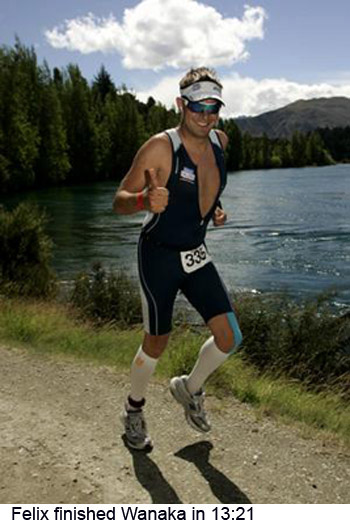
Part of this story is about declaring independence of a corporate giant and a long-term, careful planning for global expansion. But a greater part is the story is about the heart of a plucky family business that seems to be thriving as a growing David in an era of Goliaths. And perhaps business is the wrong word to start to describe what’s going on with Felix Walchshofer and his Team Challenge crew.
After all, the very young Felix Walchshofer once ran alongside the winners in the finish line chute at Roth, carrying bundles of festive bright blue balloons. This is not a cold eyed businessman immune to the aura of his champions and the thrill the average man derives from the sport. Today’s Felix Walchshofer still has that bright warm smile that graced his childhood and inherited the warmth and passion of his father. Perhaps he is not the dedicated sportsman his late father Herbert was – a two-workout-a-day man. But Felix, who inherited the family business, loves triathletes and their sport as much as the two men he is following.
So, rather than simply talk the talk that his races put the athletes first, in January Felix took on the rugged Challenge Wanaka event as his first Ironman. Halfway through his two loop run, pro Hillary Biscay stopped her chase for the podium to give the aching, wobbly Walchshofer a big, sweaty warm hug.
“It was one of the nicest moments of the race,” said Felix, who went on to finish in 13:27:37. “Here comes Hillary and she stops and says “So good to see you!”
The feeling was mutual. “These races are really special because the race director and people behind the event give their races a personal, family kind of feel,” said Biscay, who has a lot of experience to draw upon. She tackled nine iron-distance events last year. “It sounds cheesy but it’s the best way to describe the way Team Challenge people are out there interacting with and getting feedback from everyone. They’re always pitching in and volunteering, asking what can they do for us.”
The pro athletes who do his races, albeit ones who have profited from generous Challenge purses, travel money and appearance fees, give very good reviews for the Challenge races. Belinda Granger, who had four big wins last year competing in both WTC and Challenge races, thinks both are good for the sport. “For any sport to be really successful, competition is imperative,” she said in a telephone interview from Noosa. “Both WTC and Challenge have fantastic things to offer. Of course the WTC has more races, and the most important one. And they do great job for the sport. But I’m also attracted to the Challenge races because it is really run by a family. Felix takes after his father Herbert and maintains that genuine caring about the sport and the people in it. And you get that with all his other race directors – Victoria Murray-Orr in Wanaka and Guy Hemmerlin at Challenge France. Whoever runs their races has to be part of and contribute to a real, tight-knit family atmosphere.”
Granger also says that Walchshofer’s generosity with the pros is key to the long term health of his races. “Felix recognizes that it is difficult for us to make a good living from the sport,” she says. “He gives support to us in the form of appearance money, which other organizers steer clear of. He also gives out travel stipends, enough to cover to and from a race. Felix and the Challenge series consider professionals to be employees of their race, and that they should pay for our services. Since we are being paid to turn up, work hard and do a bloody good job, we are happy to do media appearances in Roth and do an array of things such as signing autographs at the shopping center, attend a lunch, go to a local high school and speak to a class. Roth is not a big town (population 23,000), and it makes an impact. A lot of professional athletes have forgotten that when you sign a contract you should do what you can as an athlete for a race and for the community. Some athletes forget that it is a two way street. Felix wants us to help the community relationship, not just perform on race day but rather several days before the race and two days after. I like working with the kids in the town and I feel very satisfied at the end of my stay in Roth.”
Granger says that the Challenge races at Wanaka and France – both a contrast in style to the high-speed track at Roth – live up to the name. “Challenge races are bloody tough races,” she says. “Wanaka is the toughest and has the most spectacular scenery. Challenge France has the toughest run course – half cross country. They’re for people who want a good honest tough course. Challenge Roth is different. It’s tough not because of terrain but because of the speed it demands. It’s steeped in history and the whole town, and surrounding region embraces the race like no other in the world. All pros should do it at least once.”
Granger says that American amateurs, particularly, should go to Roth. “For those who have not done an Ironman race in Europe, it’s hard to describe. People in Germany worship the ground Thomas Hellriegel walks on. He has not won in years, but he remains adored and idolized. While it’s not trendy to worship professional athletes at home in Australia, dyed in the wool age group athletes in Europe are not embarrassed to say ‘You are awesome.’ And that respect and love is carried expressed by huge crowds who embrace all the athletes.”
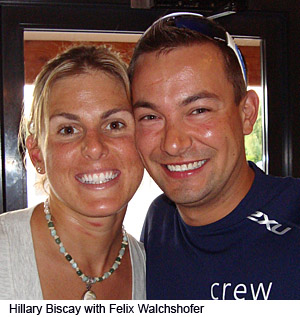
Pro Hillary Biscay, another regular Challenge customer, says the extensive drug testing at Roth (and the WTC’s Ironman in Frankfurt run by promoter Kurt Denk) is a big incentive for the majority of triathletes who value integrity. “First of all, every single pro who wants to start the race must get a blood test,” says Biscay. “They don’t have blood tests in any other country. They also test amateurs – and no place outside of Germany does that at Iron distance races. As far as testing at races, I don’t have all the facts and figures, but I can tell you I raced nine Iron distance races last year, including two Challenge races, and I won one WTC race and placed top five in almost every race I started. And yet the only time I got tested last year was at the Challenge races.”
Biscay says she understand why “there might not be an incentive to invest extensively in professionals and drug testing when all your races sell out. But Roth sells out in a minute and it is a gigantic race, the biggest Iron distance field in the world. I think Team Challenge have a long term vision for the sport and believe they will be rewarded for improving the integrity and quality of their events.”
Walchshofer sees drug testing as a guarantor of public belief in the sport. “Right now cycling has a hard time because of the drugs,” he says. “At Roth last year, all 62 pro athletes had to undergo a blood test before racing. The athletes love that we do it. They can use the results for their sponsors and in blogs to say to the world: Look, we have been tested and we don’t do drugs. For my part, our sport enjoys increasingly great mass media attention. But if we had another major drug problem (such as the Nina Kraft EPO scandals) triathlon would be hit hard. “
In fact, Walchshofer reports that in 2007, one amateur athlete tested positive and served a two year ban with the German federation.
Other competitors give Roth high marks. Australian Chris McDonald, winner at the 2008 Ironman Wisconsin and the recent Challenge Wanaka race, says; “They create truly professional races that attract international media coverage which leads to more sponsorship for events. They also do a great job of educating the spectators so the race is interesting. Even a NASCAR race would be boring to watch if the announcers weren’t filling in the personalities and strategies and rivalries and back stories. The final thing is that every athlete, from the top pros to the middle of the packer, receives top quality treatment. Nothing is missed. Every detail is checked and done with care and passion.”
Faris Al-Sultan competed at Roth twice and is a little more distant, a little more independent in his viewpoint. “Roth is very important, even from the WTC point of view, because without competition to keep you sharp, you tend to get lazy,” said the 2005 Ironman Hawaii champion. “Age group athletes, pros and sponsors all should have another choice. This alternative is especially important regarding the situation in the US, where pros don’t matter at races. They (Team Challenge) believe that pros add value to the races.”
Al-Sultan says that the organization at Roth is great but like any race has some flaws. He says that Roth’s wave starts may “oppose the original Ironman concept, but it’s worth thinking about.” Overall, he says, Roth and Frankfurt are competitive in quality. “Both big German races offer good organization. But improving athlete tracking (spotters don’t belong in the 21st Century) TV coverage (too little cameras, too little live coverage) internet live stream, vital athlete data (SRM GPS heart rate) and other things like anti-doping work are the challenges the whole triathlon community has to work on, whether it’s ITU WTC or Challenge.”
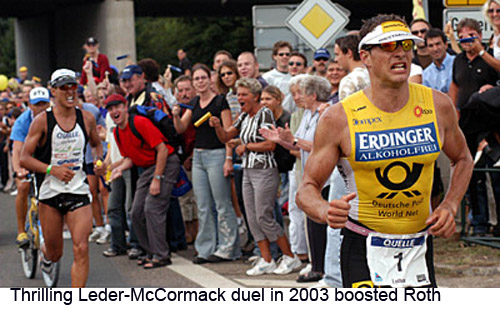
In the beginning, Roth was the first and only European Ironman. Under the guidance of race director Detlef Kuhnel, Ironman Germany aka Ironman Europe served as Kona’s twin star, a happy alternative showing the world that Ironman could also tap into the large crowds and passionate following of big time soccer or cycling. In the ‘90s, stars like Paula Newby-Fraser, Lothar Leder, Jurgen Zack, Thomas Hellriegel and Luc Van Lierde broke the 8- and 9-hour barriers, setting world best for the distance. This ignited a passion for Ironman among the German people that led to sold-out races and Tour de France scale crowds of well over 100,000. While faraway Kona created the legend and became the Holy Grail for all triathletes, Roth proved that Ironman could also be big-time sport. As Kuhnel, who took pride in what he had built, was fond of quoting the Frankfurter Allgemeine newspaper’s line: “Triathlon in Roth is like tennis in Wimbledon.”
The details of the split are now ancient history, and all three protagonists – the WTC, Roth and the new Ironman Germany at Frankfurt – have all emerged from the schism arguably stronger and better for it. But the bitter memory of the failed negotiations also helped forge a stronger Roth, more confident of its distinct identity. The lessons learned steeled its resolve and guides it into a future where it may one day graduate from its status as standalone minor alternative to an actual rival.
As Felix Walchshofer recalls the details, a picture emerges of hard nosed negotiations where both sides sought to maintain control over what they perceived as the integrity of the sport.
“By 2001, the agreement between the WTC and Roth was about to run out,” says Walchshofer. “Lew Friedland was President of the WTC and he was asking for more money, of course. But then he asked for some things which seemed strange to us. He asked that we change the bike course to one 180km loop. He did not ask this of any other race, and now Frankfurt has a multiple loop bike course. He also demanded a mass start. Our canal is 25 meters wide, and we have to swim out and back, so only half is available for swimming each way. It would have hurt the athletes to do this. It was just stupid.”
According to news reports at the time, the WTC demanded that along with a mass start, that Roth must reduce maximum entries from 2,700 to 1,800, to put it in line with Ironman North America’s then maximum entry (later raised), to “insure the quality of the race experience.” That, on top of higher Ironman sanctioning fees, would have reduced Kuhnel’s gross entry income from $900,000 to $600,000. Perhaps the sticking point was the WTC demand that Roth make a competing bid for the rights to called itself ironman Germany against the new Triangle Group based in Klagenfurt, Austria, which was starting to acquire managing control of new European Ironman races similar to the deal enjoyed at the time by Graham Fraser and Ironman North America, The Roth organization took it as an insult.
“That showed us that we had become way too important for the WTC and they wanted to crush us and put us down to the level of the other Ironmans,” recalls Felix. His father Herbert said at the time: “After 17 years of successful promoting, neither Detlef nor anyone else involved can be expected to apply to promote his own event.” Felix says now, “Then we decided this was not the way we can work. The quality of the race would be very bad if we accepted their demands.”
And so with the loyalty the Walchshofers and Kuhnel had fostered over 15 years, major sponsors Quelle and Deutsche Post remained on board, as did the city fathers of Roth and the county of Landkreis.
When the split occurred, German Ironman stars were concerned but cautiously optimistic. Thomas Hellriegel said “When I first heard the news, I thought it was really really bad. Roth is one of the best races on the Ironman circuit – maybe the best – and if the race is no more, it is really sad. But if they find a way to continue the race as it is, and give more prize money than before, it might be a good thing.”
Lothar Leder, the first man it crack the 8-hour barrier – at Roth — agreed. “It sounds negative in the beginning, but if they increase prize money and it continues to be the biggest race of its type in the world, it won’t be a loss,” said Leder. “If the WTC adds another Ironman race in Germany, it could be a win-win situation.”
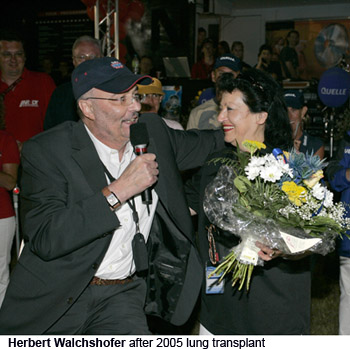
Still, the numbers would decide. In 2001, Roth had 2,465 athletes at their 14th and final race of the Ironman era. In 2002, they had 1,340 single entries. They made up some of the difference by accepting 180 relay teams with three athletes apiece. Not a purist move but it helped the race survive and made the people happy.
When the new Challenge organization put on another great race the first year, entries rose to 2,670 participants from 32 countries with 380 relay teams in 2003. And as for media splash, the Roth policy of paying appearance money to get the stars paid off big time. Chris McCormack fought a race long duel with German hero Lothar Leder which was won by three seconds at the line as huge crowds went crazy with joy. The duel excited mass media outlets like Frankfurter Allgemeine, and German national and European TV. Even without Kona slots, Roth proved they were here to stay and the race now sells out at 2,500 individual entries and 1,500 members of three-person teams to retain its title as largest iron-distance race in the world.
Since then, says Walchshofer, the race continues to play on its history and the prestige of the World record. This happens to such a degree that conspiracy theorists suspect that both Roth and Ironman Austria cut their courses short to gain notoriety.
Walchshofer denies there is any funny business and explains why the course is fast. “The bike course is actually pretty hilly,” he says. “But there are no sharp 90-degree corners which slow riders down, and the pavement is very smooth with a lot of straight, flat sections where power riders can really focus. Also, while we do have steep hills like Solarer, they are over quick and are followed by long gradual downhills where riders pick up steam. I also believe that the big crowds shouting encouragement push everyone to raise their limits.” On the run, says Walchshofer, “the course goes on firmly packed gravel and dirt trails which are easy on the legs. The path goes straight along the canals, and makes it easy to spot people ahead or behind and serves to make people run faster.” Not to forget occasional cold, rainy days like last year, on which lack of heat helps speed up the runners.
“Definitely the iron-distance world records (held since 1994 by Paula Newby-Fraser and since 1997 by Luc Van Lierde) paid off in big media attention,” said Walchshofer, who denies any distance fudging. “That and the 3-second goose bump finish of Macca and Lothar Leder in 2003, the big crowds and the big fields have drawn TV to our races. It also helped that Yvonne van Vlerken broke Paula Newby-Fraser’s old record this year, and beat the fast time set on the same day at Ironman Austria. So we still hold both records.”
Now Frankfurt draws upon its location in the middle of a large European city and may even draw bigger crowds. Frankfurt features a popular, picturesque finish line set in an ancient part of the city, and also enjoyed a nail-biting duel decided by 5 seconds a few years ago between Nicole Leder and Andrea Brede. And last year it featured a sub-8 hour finish by Chris McCormack (after four years of headline grabbing fast times at Roth), and a sub-9 hour finish by Chrissie Wellington last year which Ironman mavens rate better than Roth’s marks because the bike and run courses aren’t rated quite as Autobahn-fast as Roth.
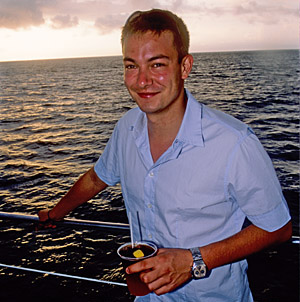
Once Roth race was on prosperous, stable ground, Walchshofer and his group Challenge team faced a reality. “Our race was full and could not grow,” said Felix. “Raising entry fees went against our philosophy that we would deliver better races and better value for the athlete. Cutting back on quality by allowing more entries was unacceptable. So we saw the only way to grow was to create more races.”
Any accountant would have thought their first choice was insanity – in the short run. Lured by the rugged beauty of New Zealand’s South Island, they decided that this jewel had to have an iron distance Challenge race. The first choice was bustling Queenstown, site of the 2003 ITU short course World championships and an international headquarters for outdoor adventure seekers with its mountains, lakes, rapids and heartbreakingly beautiful vistas ideal for skiing, mountain hiking, kayaking, parasailing, bungee jumping… Well, you get the point.
“Soon, we realized that Queenstown would present a lot of political hassles,” said Walchshofer. “Then John Allred, the CEO of Lake Wanaka tourism, invited us to hold our race there an hour north of Queenstown. He said their town would embrace our race, while in Queenstown it would be just one of many events. The way things worked out, we are most grateful. And, I think, Queenstown might now be a little sad.”
Hillary Biscay knows why they fell in love with Wanaka. “It is an absolutely visually stunning place for a race – hands down the most scenic long distance course anywhere. The 180km one loop bike course takes you through the full spectrum of New Zealand scenery – waterfalls, lakes, mountains, with snow, mountains with wildflowers, pine trees, wineries, and beautiful meadows. Because they have had a relatively small number of competitors, it’s a bloody fair race and you truly have to do the whole 180k m on your own. Plus, it’s not for wimps. The roads are paved with the old style chip surface, where your feet and hands go to sleep with the vibrations. And the run is probably the hardest at the distance – very very hilly and half of it off road. But the beautiful views as you run by a rushing river and around a lake make all the suffering worthwhile. It’s just awesome.”
Artistic as it might be, Wanaka is a tiny village and it’s an hour away from Queenstown’s small airport. The first year, using an Auckland-based sports event production company, Wanaka drew just 60 single entries. “After the race, we decide it would be better for us and the race to get a new organization involved run by local Wanaka people,” said Walchshofer, who admits they took an economic bath that first year but won’t cite figures. “When an outside organization came in, the town didn’t get involved. So we picked Victoria Murray-Orr as the race director. She had organized a lot of cultural and sporting events in Lake Wanaka like the Burton Snowboard contests and a Festival of Colors in Autumn. Under her leadership, when the event became their own, the community took ownership. For as town of 3,000, they drew 450 volunteers. And had 80 people do the race.”
As with Roth, local organizers turned the race into a weeklong festival with local fun runs, a triathlon for schoolchildren, and a local points series short course triathlon. Visiting athletes and their families from 21 countries were treated to a fantastic sightseeing tour of the nearby New Zealand Alps and breathtaking countryside. The second year single entries rose to 100, and then hit 160 in 2009. Mixed with teams, the total entries reached 500 this year, and Walchshofer says Wanaka now “stands on its own and is economically feasible.” After all, he says, “It took ironman New Zealand almost 20 years to sell out their race. Because we are a private company, and are not part of any big group, we do not have to rush to get as much money in a short amount of time like other organizations in triathlon might have to. We have the time and the will look toward the future.”
To hard nosed business men, Wanaka was less of the foundation for a new international series than a daft infatuation with a Kiwi Eden, an idyllic Shangri-la that would never do box office. After achieving an artistic success and eking out a break even start at Wanaka, Team Challenge seemed to find its stride. The next race was a half Iron distance race in Niederbronn-les-Bains in northern France. “Why did we choose it?” asks Walchshofer. “Again, it is a beautiful venue in a fantastic natural park with heaps of trees and rivers and streams in a small town with a refurbished casino, a busy marketplace, and cafes where family members of the athletes can sit and watch the athletes bike and run past. It is very charming, very much representative of the French countryside.
For the athletes, Walchshofer says, “a key feature is that they close down the whole town for the cycling and the run.” The first race sold out all 1,200 spots in three months and is set for June 7. “This is an unqualified financial success. And that’s why we consider all our races so carefully. In this financial climate, we can't afford a mistake.”
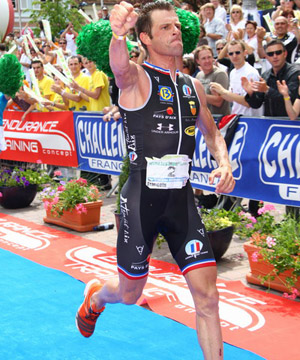
This year’s Challenge debut races are following the emerging blueprint – no big urban spectaculars. Find a small, rural or exurban village or town set amidst surpassing natural beauty with challenging and inspiring terrain. Secure the enthusiastic support of the town, and choose race directors who well know the Challenge methods and philosophy. “We have inquiries come in every week from people who want to hold one of our races. But we have high standards and for some reason or another we have to turn most of them down,” says Walchshofer.
So the new 2009 Challenge lineup has grown to include the new races. The half-distance Evolution Challenge Barcelona Costa de Maresme, located 31 kilometers from Barcelona in the seaside resort of Calella de Mar, population 17,000, on May 24; the half-distance Challenge Kraichgau in Germany on June 24, and the long distance Challenge Barcelona Costa de Maresme which will be held October 4. The Barcelona races break from the Challenge mold somewhat, as the bike is a straight out-and-back along a largely flat coastal highway and the run is equally flat, going along the seaside promenade. In Kraichgau, Challenge has licensed the successful four year-old Kraichgau Triathlon run by Thomas Hellriegel’s brother Stefan. The brother of the legendary Hellriegel says joining forces with Team Challenge was a natural. “Nearly everyone with our race tem has raced in Roth many times. And when we were not racing we were standing e on the race course as spectators. Roth was always special experience for us. It was the race that brought the sport to Europe and its tremendous success helped shape the sport here in Germany. The Challenge in Roth is a triathlon of the heart, and it was in this spirit we organized Kraichgau.”
The Challenge organization also had some scheduling strategy at work in the choice of new races. “We wanted a half distance race that would serve as a good preparation race for Roth,” said Walchshofer. “And with Ironman Hawaii always sold out and many athletes in Europe lacking a good late season long distance race, we thought October 4 in Barcelona would be very popular.”


